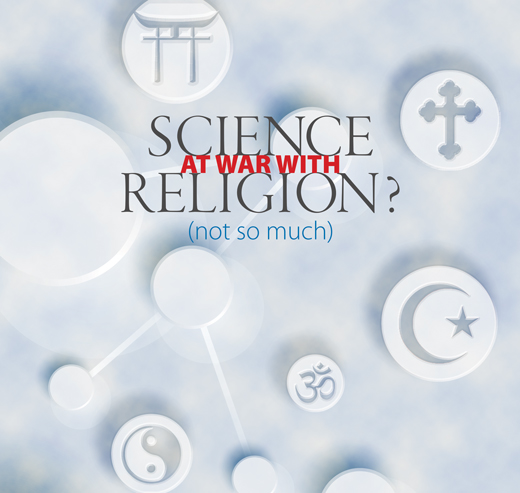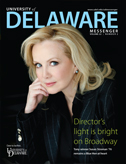
ALUMNI | Lawrence M. Principe, AS83, earned bachelor’s degrees in liberal studies and in chemistry at UD and went on to earn two doctorates—in organic chemistry from Indiana University and then at Johns Hopkins, in the history of science. He now is the Drew Professor of the Humanities at Johns Hopkins, where he also directs the Charles S. Singleton Center for the Study of Premodern Europe. In 2004, he was the first recipient of the Francis Bacon Medal for his significant contributions to the history of science.
In May, Principe received an Outstanding Alumni Award from UD’s College of Arts and Sciences, but he had also been back to campus in April. At that time, he delivered a public lecture, “The Stubborn Myth of the Warfare of Science and Religion.”
Here are several excerpts from his prepared remarks.

My topic for this evening, the conflict between science and religion, is a topic that seems familiar enough. But such familiarity frequently turns out to be deceptive. What I mean is that while virtually everyone has heard about a conflict between science and religion—and can perhaps rattle off a few illustrative examples (Galileo usually being at the top of the list)—there is usually far less appreciation of the origins of the notion or of the validity of the historical claims upon which it is based.
Thus, it still too frequently comes as a surprise that no serious historians of science accept the notion of a longstanding or inherent conflict or warfare between science and religion. In contrast to the frankly silly rantings the popular press loves to report between the two flavors of fundamentalist (the religious and the scientistic), the historical interaction between “science” and “religion” has been complex and varied, and often cooperative. Despite unanimous rejection of the conflict model by the very people—historians of science—best qualified to judge it, the model remains strong today.
So let’s explore now both the origins of the conflict model and the causes for its continued survival despite overwhelming evidence against it.
The idea of a more-or-less constant state of warfare between science and religion—and the often accompanying claim that science has a special, or indeed an exclusive, access to truth—arise from the same set of historical sources, some intellectual, some political and some very personal. Some of the intellectual roots lie with the legacy of Comtean positivism, a formulation deriving from the ideas of the early 19th-century philosopher August Comte … [which] implied that theistic religion belonged to a “primitive” state and science to a “mature” state of humanity.
Comte’s Law of Three Stages was soon both popularized and interwoven with the notion of perpetual struggle between science and religion in John William Draper’s 1874 History of the Conflict Between Religion and Science. … Draper’s “Universal Law of Development” guides the book, but here it is combined with a specifically anti-Catholic rant that often reaches the level of the hysterical:
“Roman Catholicism and Science are recognized by their respective adherents as being absolutely incompatible; they cannot exist together. … Mankind must make its choice—it cannot have both.” This statement would imply that a Roman Catholic scientist could not exist, contrary to the evidence of one’s senses, both in 1874 and today.
Draper’s hatred of Catholics is part and parcel of widespread late 19th-century American anti-Catholicism and xenophobia, particularly against newly arriving Catholic immigrants. …
Draper’s Conflict was soon joined by an early version of the second major book to promote the idea of perpetual warfare between science and religion, Andrew Dixon White’s 1876 Warfare of Science. White, the founding president of Cornell University, had begun speaking publicly about the “battles” between science and religion in 1869, and his efforts culminated in a massive two-volume History of the Warfare of Science with Theology, published in 1896.
White’s work proved less popular than Draper’s, does not show Draper’s rabid anti-Catholicism and was more extensively footnoted, which gave it the patina of scholarly authority. White’s tone is somewhat more placid (although frequently melodramatic), arguing that religion is good in itself, but should stay out of the way of science, for their interaction damages both.
You might well wonder what impact books—in fact, bad books—over a century old could have today. The answer is astonishing: These may be among the most influential books of the past 150 years. Although few people today have actually read either of them, or perhaps even heard of them or their authors, nevertheless the erroneous historical notions they invented or popularized have become naturalized as facts in contemporary culture.
Let me ask you a question. How many of you were taught as schoolchildren (as was I) that before Columbus everyone thought the Earth was flat? It’s a lie. But this lie was popularized by Draper’s and White’s books.
This canard was originally confected by the fiction writer Washington Irving in his romanticized Life of Columbus, but was presented as historical fact by Draper and further embellished by White. Likewise, the assertion that the Catholic Church forbade and/or punished human dissection was another false claim that both Draper and White popularized, along with countless other falsehoods about the history of science and the history of religion.
Citing the factual errors of these two authors would take all night, so I will pass then to their fundamental methodological error—namely, the assumption of the existence of two distinct groups, religionists and scientists, that simply did not exist as such before the late 19th century. Virtually every contributor to scientific knowledge in Europe before the 19th century was also a believing Christian, many very deeply religious, and many of them clergy.
Historical examples of the inseparability of the supposed camps of scientists and religionists are easy to enumerate to the point of exhaustion:
Robert Boyle, the champion of chemistry and discoverer of the fundamental gas law that bears his name, was called in his eulogy a “lay bishop,” and his books divide fairly evenly between scientific and theological topics. Isaac Newton (1642-1727) devoted at least as much time to theology and Biblical studies as he did to mathematics or physics.
And it is trivially easy to cite a long list of scientific work and achievements from the Middle Ages to the present carried out by ordained priests: St. Albert the Great’s work on mineralogy and embryology, Pierre Gassendi’s revival of atomism, the Jesuit Athanasius Kircher’s descent into the crater of an erupting Vesuvius to make observations, Giovanni Battista Riccioli’s experiments to measure the constant of gravitational acceleration, Niels Steno’s observations of fossils and strata that set the foundations of modern geology, John Ray’s botanical classification system, and, in the 20th century, Georges LeMaitre, the Belgian Catholic priest who held degrees in the sciences from Cambridge, Harvard and MIT and who first proposed Big Bang cosmology.
The topics of magnetism, optics and seismology were, at various times, virtually Jesuit monopolies, and for part of the 18th century, over half of European university chairs in mathematics were occupied by Jesuits.
To say a few words about perhaps the most famous case regarding science and religion, the supporters and detractors of Galileo were evenly distributed among ecclesiastics and laymen, and both criticism and support of his system of the Earth’s motions came from both theological and scientific knowledge. While some churchmen and secular professors criticized him, others praised him; for example, the Jesuits at Rome gave him a celebratory feast to mark his telescopic discoveries, and Galileo liked to quote Cardinal Cesare Baronio who quipped, “The intention of the Holy Spirit is to tell us how to go to heaven, not how the heavens go.”
The point is that Draper and White were illegitimately transporting the emerging social stratifications of their own era backwards into earlier times. By constructing the notion that two rival camps—scientists and religionists—had existed throughout history, they set up an inherent and essential rivalry between science and religion that simply did not exist as such.
How does one wean people off of the conflict model? That’s going to be difficult so long as it serves a useful function—for scientists insecure about their social and political position, for fundamentalists insecure about their political clout and the size of their congregations and, most of all recently, for atheists insecure about their choice of religion. But certainly getting the history right is the first step.
In conclusion, not only was the warfare model built—and is perpetuated upon—fabricated history and personal-professional insecurities, but it also serves to obscure the richness of the history of the real interactions of science and religion.
Lawrence Principe (excerpted from a talk at UD)






